Unlock Business Insights with Accounts Payable Reports

Ever wish you could quickly review key AP metrics?
Maybe you want to know how much working capital you’ll have next quarter.
You may want to know how fast your AP team processes invoices.
Or maybe you need to know how much your company is spending, and who is spending it.
Accounts Payable reports give you full visibility into accurate and actionable accounts payable data – and full control over your spending.
Use reports to optimize cash flow, monitor team performance, identify process bottlenecks, control human error and fraud, and keep your whole accounting team on the same page.
Keep reading to learn more about the types of AP reports, how they can benefit your business, and how you can access real-time, actionable metrics with accounts payable automation.
Let’s dive in.
What are Accounts Payable reports?
Accounts payable reports give business owners and finance leaders insight into key AP metrics and KPIs. We can group AP reports into two categories:
- Payables reports that show cash outflows and liabilities
- Performance reports that show invoice processing efficiency
Payables reports
Payables reports give information about outstanding supplier balances, liabilities, payment due dates, and vendor payment history. Use these accounting reports to manage cash flow, optimize working capital, control errors and fraud, and make strategic vendor management decisions.
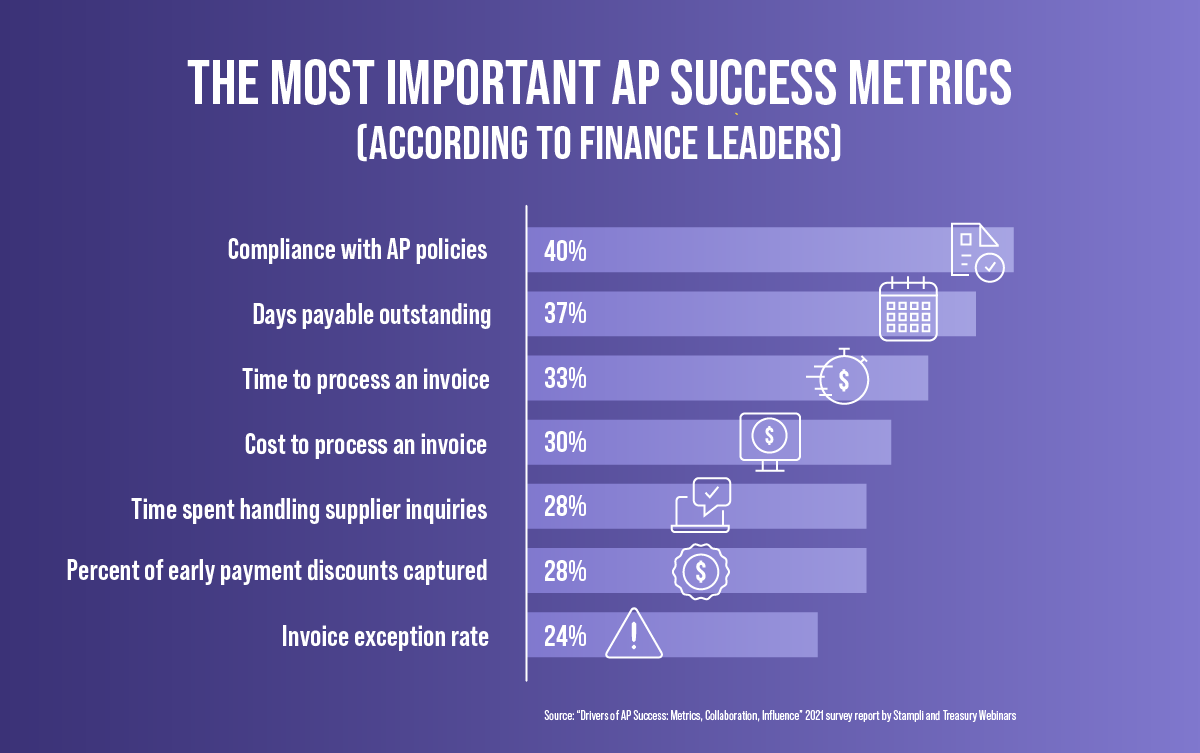
Performance reports
Performance reports give insights into invoice lifecycles, employee productivity, and AP processes. Use these reports to identify bottlenecks, manage staff workloads and performance, and improve processing efficiency.
Many AP reports can provide insights into both payables and performance. For example, aging reports help you understand your liabilities and cash flow position. They also provide insight into possible processing bottlenecks causing delayed payments.
Let’s look at the standard reports used in AP and how they can benefit your business. We’ll use reports from Murphy’s Homeworks, a fictitious home renovation company, to help explain how you can use AP reports to better handle your accounts payable.
Types of AP reports
We recently implemented an AP automation solution at Murphy’s Homeworks. As part of the solution, we now have access to various real-time AP reports.
Accounts payable aging report
The AP aging detail report shows the total amount due to vendors, grouped into 30-day increments. For example, an aging report could show current bills (not overdue) and bills 1-30, 31-60, 61-90, and 90+ days past due.
We can use the AP aging report to calculate days payable outstanding (DPO), which measures the average number of days our company takes to pay suppliers. We can also use it to prioritize vendor payments and forecast future cash requirements.
For example, here is our aging report for July. We’re up to date with Stoneworks, but we have outstanding balances with two other vendors.
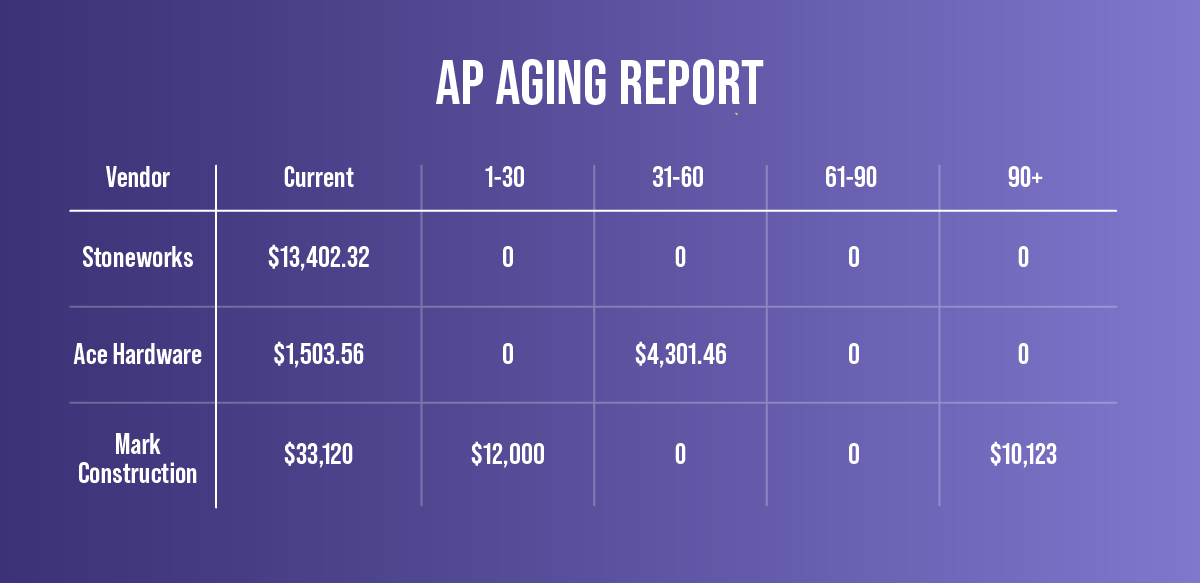
AP turnover report
Like the aging report, the AP turnover report shows how fast our company pays suppliers. We use it to monitor trends in our AP turnover ratio (the average number of times we pay our AP balances during a specific period). Changes in the AP turnover ratio can indicate our company’s liquidity position, making it a good way to monitor how well we manage our cash flow. For example, a sharp decrease in our AP turnover ratio could indicate our company is having difficulty paying our suppliers.
History of payments report
The payment history report shows all our expenditures for a specific time frame. We can break the results down by expense category, project, or vendor to provide deeper insights into spending within a date range. We use the payment history report to ensure our actual spend aligns with our budget and forecasts, monitor vendor relationships, and control internal spending.
Continuing our example above, our Q2 history of payments shows we’ve paid Stoneworks every month.
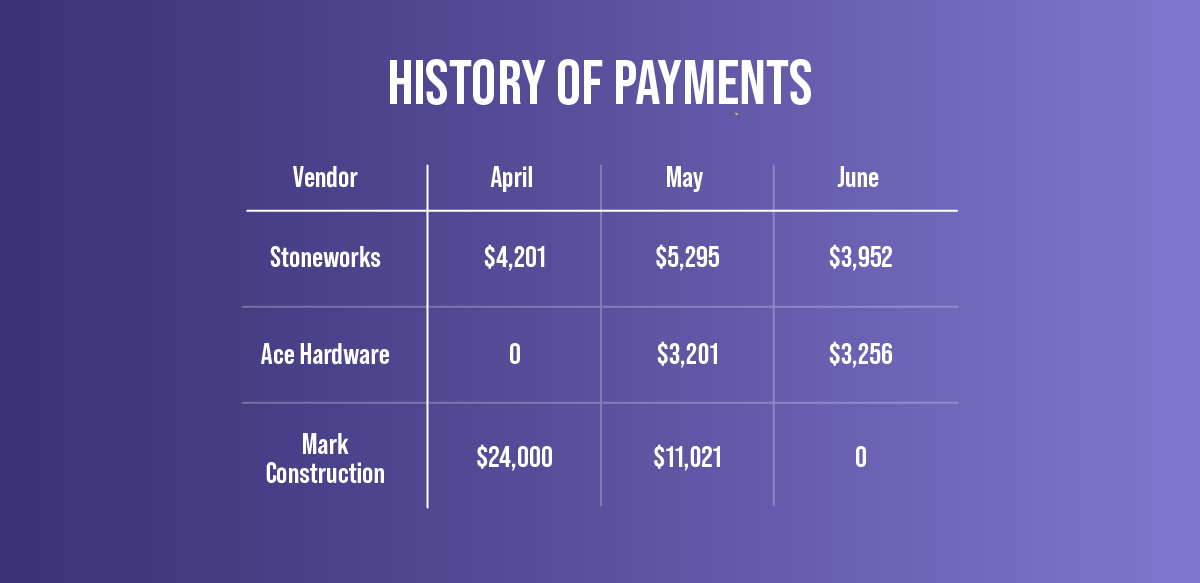
We didn’t pay Ace Hardware in April, which is reflected in the 31-60 day column in the aging report. There’s no dispute on record with Ace for that month, so we’ll investigate the missed payment.
We’re also in a billing dispute with Mark Construction – we issued partial payment in May and didn’t pay them in June. The disputed amount ($10,123) shows up on the aging report in the 90+ day column, and the outstanding balance in our May partial payment shows up in the 1-30 day column.
Voucher activity report
The voucher activity report lets us track expenditures by project, location, or department. By tracking vouchers – which document approved payments to vendors – we can use the report to look at expenditures by specific groups, projects, and locations.
AP trial balance report
The AP trial balance report lists the debits and credits to each general ledger (GL) account. We use it to ensure our accounts balance and that expenditures are coded correctly. We can summarize expenditures by date, vendor, project, or other category to get a more detailed view of our spending.
Vendor information report
Vendor reports list vendor names and outstanding balances. We use this report, along with the payment history report, to prioritize vendor payments, forecast future payments, and assist in negotiating supply contracts or discounts.
In our example, our vendor information report shows the total balance (the sum of the current balance and any outstanding balances) we owe each vendor.
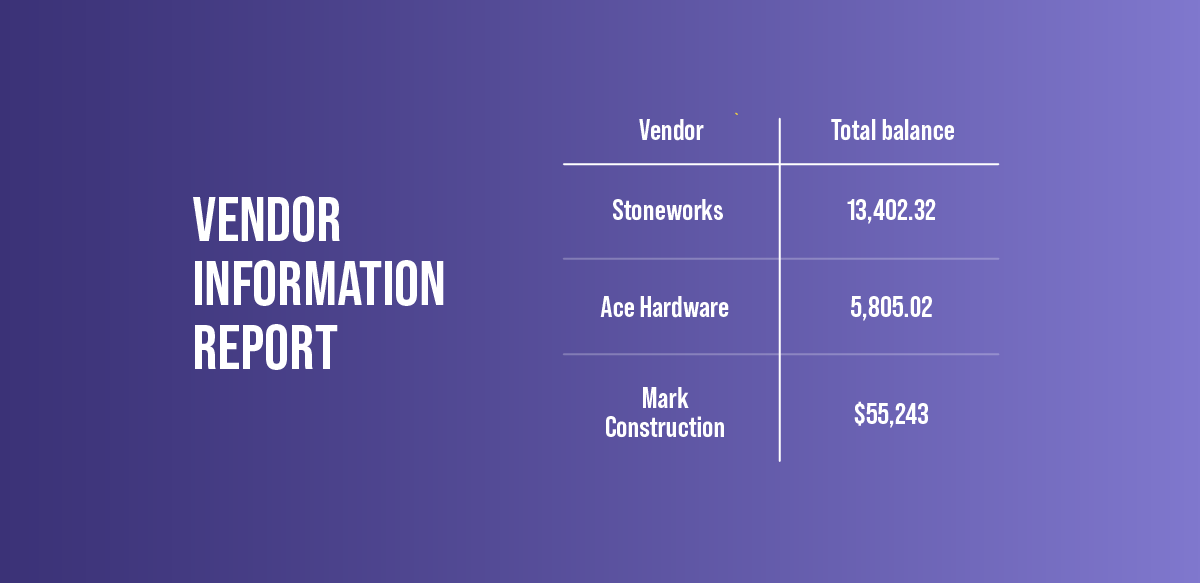
The report may have revealed a billing error. We noticed that the total balance for Stoneworks is $13,402.32. We know from the aging report that this is our current balance with them. However, when we look at our payment history for Stoneworks, we see that our monthly spend with them is usually around $4-5,000. We’re going to investigate this transaction to see if Stoneworks sent us a duplicate invoice or if our AP team entered an invoice twice.
Credit memo report
Vendors issue credit memos when goods are damaged, returned, or priced incorrectly to reduce the amount owed on a current invoice or offset a future invoice. The credit memo report shows the currently available credits by vendor. We use the credit memo report to ensure we apply any outstanding credits to future invoices.
Discount report
Discount reports show supplier discounts, such as early-payment discounts, our company receives from suppliers. We use the discount report to identify discounts we may have overlooked and to make informed purchasing decisions in the future.
Account reconciliation report
The account reconciliation report reviews the accounting activity related to issued payment vouchers for supplier debts in a given period. We use it to verify open or outstanding liabilities against our GL accounts to ensure we make the right payments to the right suppliers and that all journal entries are accurate. We compare the account reconciliation report against our general ledger to identify errors, signs of fraud, or incorrect payments to suppliers.
How AP reports benefit your business
AP reports let CFOs, controllers, and accounts payable managers make strategic, data-driven decisions about optimizing AP workflows and managing cash flow. Here are some of the key benefits to your business:
Make strategic cash flow decisions
Analyze your company’s spending by category, vendor, location, or department to ensure you’re spending money efficiently. Use this information to anticipate future expenses and make spending decisions to maximize working capital.
Identify and respond to trends
Identify and respond to trends that reveal crucial insights about how your business spends money. For example, if you notice an unusual increase in erroneous payments to a specific vendor, it could indicate signs of fraud.
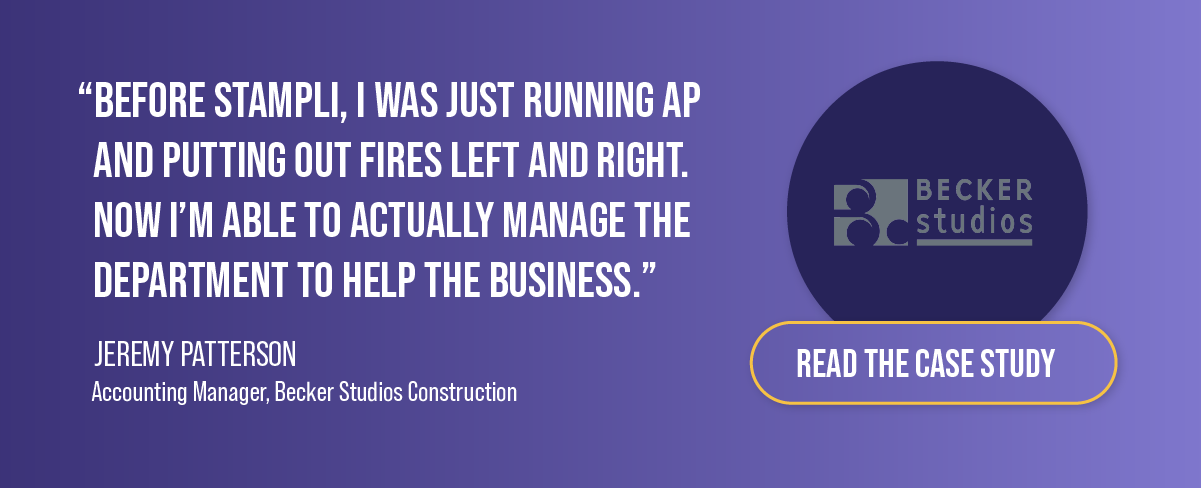
Optimize supplier payment terms
Use KPIs like DPO and invoice processing times to optimize your AP workflows and improve payment times. By improving how fast you pay invoices, you can negotiate discounts and more favorable contract terms with suppliers.
Improve vendor relationships
Leverage vendor reports to be more open and transparent about your business relationships with vendors. Open communication makes resolving billing disputes and negotiating good contract terms easier. For example, if a vendor complains your company is chronically late making payments, you can work with them to identify and address the cause.
Leverage AP automation for real-time accounts payable reporting
AP automation solutions coupled with built-for-AP analytical and reporting functionality are ideal for optimizing your accounts payable.
AP reports help your business meet its obligations, process invoices efficiently, and better manage cash flow. While you can generate financial reports using an Excel spreadsheet, ERP, or accounting software, AP automation solutions provide much deeper benefits to your business. AP systems can automatically retrieve information from vendor invoices, purchase orders, accounting systems, and bank accounts to provide accurate, real-time transaction and AP performance data.
Strategic Accounts Payable reporting with Stampli Insights
Get full visibility into your Accounts Payable data with Stampli Insights. Your AP team can access powerful tools – built directly into the most powerful Accounts Payable Automation solution – to understand invoice processes, employee workloads, invoice status, and more. Stampli Insights works right out of the box without coding or IT support, and it provides key metrics and KPIs in a clear and accessible visual dashboard.
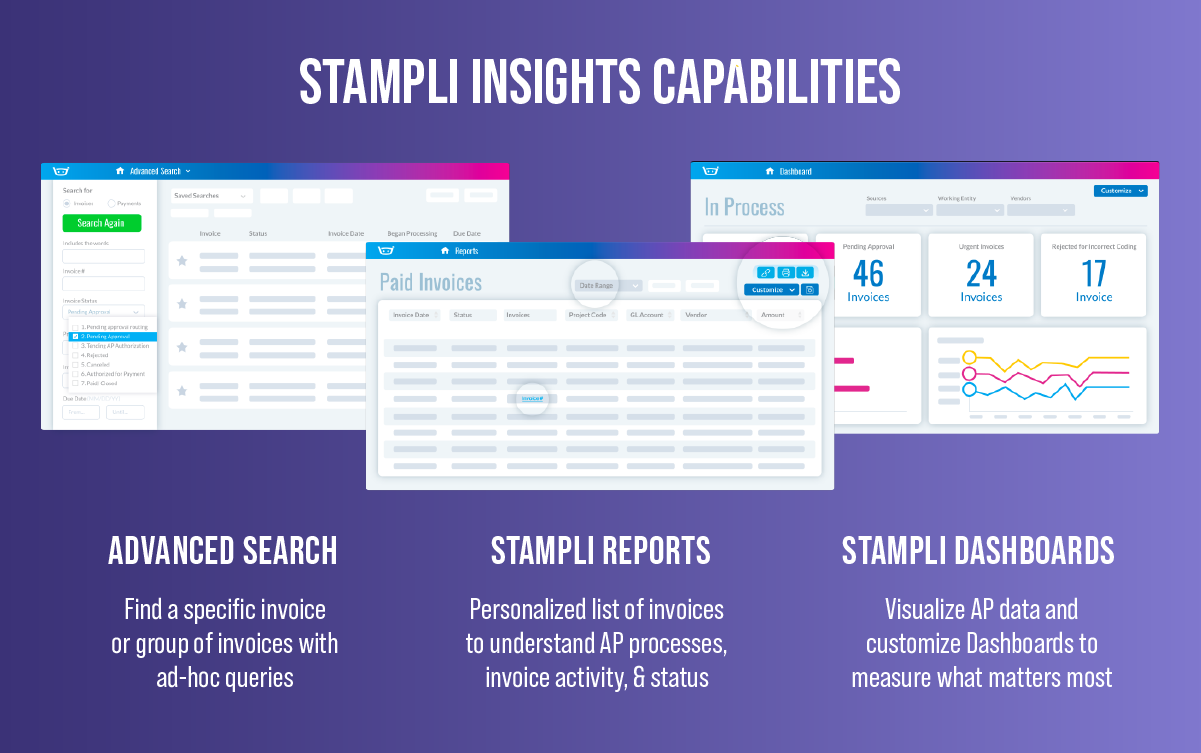
Stampli Insights gives you total visibility into your Accounts Payable data in the most powerful AP Automation solution. Your AP team can easily access a wide range of tools to understand invoice processes, employee workloads, invoice status, and more. Stampi Insights provides key metrics and KPIs in a clear and user-friendly visual dashboard, empowering your team to review and analyze important accounts payable metrics effortlessly.
Here’s how Stampli Insights can help you turn AP into a strategic driver:
Visualize Accounts Payable data with Stampli Dashboards
- Obtain comprehensive insights into your AP data by leveraging three pre-built dashboards and interactive widgets
- Assess key AP metrics at a glance or use filters for a more detailed analysis
- Tailor your dashboards to display the precise AP data you require
Customized Invoice Views with Stampli Reports
- Generate 10 built-in AP reports effortlessly, providing detailed invoice information
- Create and save custom reports for convenient future access
- Share your reports with your team in CSV, XLSX, and PDF formats, or print them out for added convenience
Advanced Ad-Hoc Search Queries
- Quickly access information on specific invoices and payments using our built-in search engine
- Refine search results with specific criteria, including invoice status, vendor, PO, or category
- Create and save custom searches through our user-friendly interface
Discover how Stampli can streamline your AP processes and help your business save time and money. Contact us today to learn more about the strategic benefits of instant insights into your AP data.
